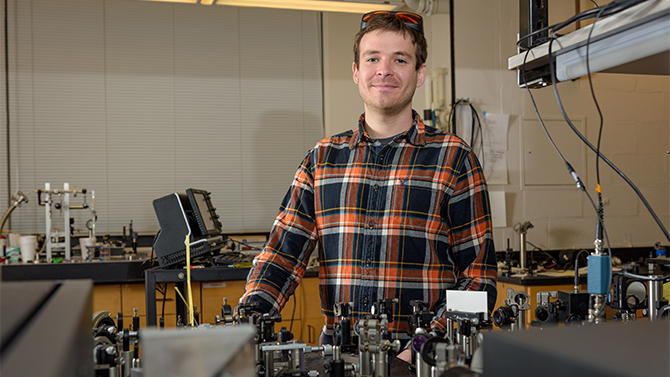


Ultrafast research
Photo by Evan Krape April 19, 2017
UD doctoral student wins time with Argonne Lab's synchrotron
To the generations of scientists who have endured decades of slow-paced progress, the concept of "ultrafast research" might seem a contradiction in terms or someone's idea of a cruel joke.
But chemical reactions and molecular changes happen in ultrafast time and that is the kind of research that draws Baxter Abraham, a fifth-year University of Delaware doctoral student from Orlando, Florida.
The kind of speed he's talking about is measured in femtoseconds, each of which is one quadrillionth of a second, a million times faster than a nanosecond.
Try as they might, our brains just can't slice a second that thinly. But with the right instruments – such as the Advanced Photon Source synchrotron at Argonne National Laboratory – scientists can get much closer.
This is important for the development of new understanding and technologies in chemistry, biology, physics, engineering and more.
Under the guidance of UD physicist Lars Gundlach, assistant professor with appointments in chemistry and physics whose ultrafast research looks at the transport of energy and other processes at the nanoscale, Abraham is specifically studying heterogeneous electron transfer for application in solar cells and conversion of solar energy. The growing field of molecular electronics will rely on such study.
Now Abraham has won support from the U.S. Department of Energy's Office of Science Graduate Student Research Program to pursue part of his thesis research at Argonne. He is one of 53 winners nationally, representing 45 different universities, who will work at one of the department's 14 national laboratory sites with one of its scientists.
"In the past couple of years Baxter’s dedication and hard work helped to build the basis for a DOE-funded project," Gundlach said. "This commitment now allows him to spend a summer at a national lab. It is an opportunity that will strengthen his scientific background and more important it will expand his network and help him to start his career."
To be sure, Gundlach and his UD team have developed an extraordinary instrument of their own, which resides in Lammot du Pont Lab. With a complex array of lenses and light sources, Gundlach's team has developed techniques to study dynamic processes that will inform much innovation and practical application.
Argonne's synchrotron uses heat and electromagnets to produce the powerfully fast X-rays Abraham wants to learn from. The speeds there reach picoseconds, which – at one trillionth of a second each – are plenty fast but still not quite as fast as femtoseconds.
With that kind of speed, though, scientists can see how a structure changes in the crux of a chemical reaction.
"Here, we can see how a molecule is moving," Abraham said. "There, they can directly see the structure and see how the bonds are growing or shrinking within a couple of picoseconds."
Does the transfer of an electron change the structure? Is energy lost?
If you consider the femtosecond, it's hard to imagine how much can happen in such an unimaginably short period of time.
For one thing, light travels 300 nanometers – about 1/100,000th of an inch - in the span of one femtosecond. That's not a great distance – you wouldn't notice any change just watching with your eyes or even a microscope.
"But a lot of chemistry and chemical reactions happen that fast," Abraham said. "... And if you know what's going on, you can build a molecule around that."
And do all sorts of new things.
Abraham will leave for Argonne at the beginning of June.
About the award
The Department of Energy's Office of Science Graduate Student Research Program award covers travel costs and a monthly stipend of up to $3,000 for living expenses during the period of collaboration with the national laboratory, from three to 12 months.
“The SCGSR program prepares graduate students for science, technology, engineering, or mathematics (STEM) careers critically important to the DOE Office of Science mission,” said Steve Binkley, acting director of DOE’s Office of Science. “We are proud of the accomplishments these outstanding students have already have made, and look forward to following their achievements in years to come.”
About Argonne National Laboratory
The 70-year-old Argonne National Lab in Argonne, Ill., has capacity and facilities for a wide range of studies, including accelerator science, advanced computer science, materials science, applied mathematics, biological and bioprocess engineering, chemical engineering, molecular science, atmospheric science, condensed matter physics, cyber science, nuclear engineering, particle physics.
Its Advanced Photon Source synchrotron – a giant circular track that covers two-thirds of a mile – runs 24 hours a day to give scientists constant access to its powerful X-rays. It has 35 sectors and is designed to accommodate dozens of experiments at once.
Contact Us
Have a UDaily story idea?
Contact us at ocm@udel.edu
Members of the press
Contact us at 302-831-NEWS or visit the Media Relations website

